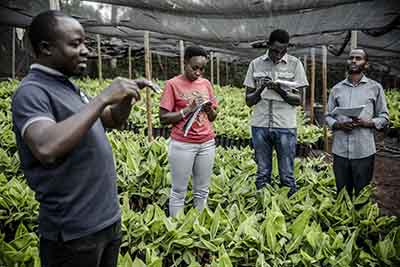FAO in Review: How the Organization changed its Business Model through innovation
FAO Director-General QU Dongyu visits a meteorological laboratory in Vientiane, Lao PDR. © FAO/Chalinee Thirasupa
Over the past 40 months, the impacts of an unprecedented wave of complex and sometimes overlapping challenges, including a global pandemic, conflicts and crop-pest outbreaks have not caught FAO unprepared. On the contrary, the Organization has demonstrated a readiness to adapt rapidly and agiley and thus respond to the changes effectively and efficiently, in line with its mandate.
FAO’s ability to be fit-for-purpose in the context of such new realities is rooted in its transformation, under Director-General QU Dongyu, towards a reinvigorated business model based on innovative working methods.
A series of reforms, including a revised organigram, new offices, thematic strategies and initiatives have made the Organization more flexible, open and transparent, digital, integrated, partner- oriented and trusted. This transformation is also encapsulated in the FAO Strategic Framework 2022-31 which highlights the importance of a shift in FAO’s working paradigm and includes accelerators on innovation and technology, with each of the 20 Programme Priority Areas underpinned by science.
Innovation is at the forefront FAO’s work
True to his pledge to augment FAO’s position as a knowledge hub, the Director-General established the first ever FAO Chief Scientist position to ensure that the Organization has a strong science-based voice, while the Office of Innovation, created in 2019, ensures that FAO mainstreams innovation in its programmes, facilitates cross-collaboration between the various FAO units, and aids in forging and reinforcing transformative partnerships. Similarly, the establishment of the first ever dedicated Office of SDGs within the UN wide system reflects how the Goals are central in FAO’s overall theory of change under its Strategic Framework.
In addition, the new FAO Science and Innovation Strategy will enable the organization to step up its efforts in the transformation of agrifood systems through the provision of Organization-wide guidance, coherence and alignment on science and innovation. The Strategy is grounded in seven guiding principles including the need to be gender-equal, evidence-based, needs-driven, risk-informed and ethics-based. It focuses on three pillars: strengthening science and evidence-based decision-making; supporting innovation and technology at regional and country level; and, serving Members better by reinforcing FAO’s capacities. Two enablers are mainstreamed throughout the three pillars: transformative partnerships and innovative funding and financing.
It will be implemented in synergy with the FAO Strategy on Climate Change which responds to the worldwide challenge of tackling the impacts of the climate crisis and accelerating agrifood systems-related climate actions at global, regional, country and local levels and across sectors ensuring that all actors, especially small-scale producers, are fully enabled, empowered and involved in decision-making processes.
FAO’s digital transformation is contributing to the development and sharing of FAO public goods through the application of Information Technology, big data and Artificial Intelligence. This process continues to reach new milestones, with the FAO dedicated webpage on the recently launched One Country One Priority Initiative that serves as a platform for facilitating the sharing of experiences among project countries.


Left: A FAO-organized farm tour in Kenya where youth can interact with local farmers and producers. © FAO/Luis Tato; Right: FAO provides technical support to countries investing in modern technologies to build sustainable and profitable aquaculture production. © FAO/FameMedia
Targeting Members’ needs
The strategic review exercise concluded this year for the Technical Cooperation Programme – which enables FAO to make its know-how and technical expertise available to Members upon request - has set it on a new course and has increased transparency, with updated criteria and methods for resource allocation to regions and within regions. FAO has accordingly streamlined, modernized and simplified the project cycle so that it is tailored for different types of projects.
Moreover, FAO’s project work has been enhanced through the use in the field of modern technology, including putting informative digital apps at the fingertips of farmers and other rural communities, and is better equipped to support investments that directly benefit smallholders.
In recognition of the need for FAO to have a modern and efficient decentralized offices network to ensure optimal support to Members at the country level, the Director-General launched the reorganization of capacities within the structures of the Regional Offices following the new headquarters’ model – to work better together as ONE FAO. FAO’s work at the country level also stands to benefit from the Joint Mentorship Programme which now has an active online system for matching mentors and mentees, and is geared to enhance support to decentralized offices, including through the appointment of Regional Counsellors.

Villagers in Bangladesh use a computer tab as a learning device. FAO’s project work has been enhanced through the use of modern technology, including putting informative digital apps at the fingertips of farmers. © FAO/Mohammad Rakibul Hasan
Bringing FAO back-on-track as a centre of excellence
Since its inception the World Food Forum (WFF) has played an important role for FAO to transform its business model, and this was evident at the 2022 flagship event Global Youth Forum which took place in mid-October 2022. The innovative, intensive and ground-breaking week for FAO also included the Science and Innovation Forum and the Hand-in-Hand Investment Forum as three diverse yet interlinked tracks.
With inclusivity at its core, the Forum brought together shareholders from across agrifood systems and fostered an intergenerational dialogue among global leaders, youth groups, investors, private sector, scientists, innovators, researchers, Indigenous Peoples, artists, cultural leaders and more.
In particular, the Science and Innovation Forum, focused on harnessing science, technology and innovation for the transformation of global agrifood systems and included the in-person participation of over 300 leading scientists, innovation experts and policy makers with discussions exploring scientific and technological advances, and the associated risks and opportunities. Together with the other two tracks, it has propelled FAO back-on-track as a centre of excellence through its knowledge platforms.
FAO’s Chief Scientist, Ismahane Elouafi, said: “I am seeing a really exciting shift happening, where science, technology and innovation are becoming driving forces behind how we think and talk about FAO’s work – both internally in FAO and among our Members and stakeholders. Due to the success of the Science and Innovation Forum it will now be an annual event, and we have also launched an important new biennial flagship publication, the Agrifood Systems Technologies and Innovations Outlook (ATIO). The overall aim of ATIO is to curate data and analyses from numerous sources to aid agrifood systems’ decision-makers around the world.”
Beth Crawford, Officer-in-Charge of the Office of Innovation, said: “One aspect of the Office of Innovation’s new business model is to further catalyze and showcase innovative thinking and practices across the FAO ecosystem. In this regard, we will shortly be launching a call for proposals for the new Innovation Fund, so stay tuned!”
